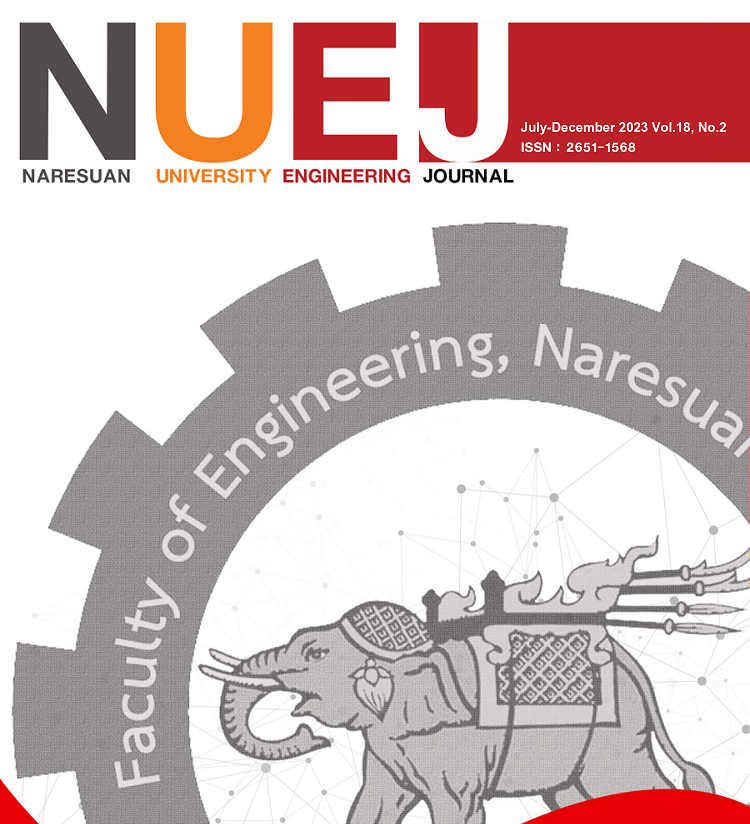New Classification of Textile Samples through lp Norm Spectral Enhancement Using Template Filters Combining the Analytic Geometry Technique
Main Article Content
Abstract
This paper introduces a novel method for classifying textile fibers into three groups: natural fibers, synthetic fibers, and blended fibers using near-infrared (NIR) spectra obtained via the NeoSpectra-Micro sensor. Our approach involves preprocessing and employing the lp-norm with p = ∞, 1, and 2 to enhance spectral signals. These enhanced signals alongside textile template filters were obtained from both natural and synthetic fiber groups. Next, the template filters are used to construct a new 2x1 feature vector through covariance-based techniques to effectively reduce spectral data dimension. The feature vector is pivotal for establishing two threshold lines together with an analytical geometry technique to classify for accurate fiber groups. To evaluate the performance of the proposed method, experiments were conducted by using three groups of fiber samples: 210 natural fiber spectra, 480 synthetic fiber spectra, and 270 blended fiber spectra. The dataset was divided into training and testing sets with ten random iterations exploring eight ratios and lp-norm enhancements for training and evaluation. Remarkably, the experimental result has shown that the overall accuracy remains consistent across the three cases of the lp-norm enhancements providing the similar accuracies. Considering the limited computational resource, the l1-norm emerges as a practical choice for embedded systems, emphasizing its practicality for implementation. Moreover, the proposed method additionally provides high accuracies (mean ± standard deviation) of 0.9995 ± 0.0006, 0.9999 ± 0.0004, and 0.9999 ± 0.0005, whereas the ratio of the train and test data is equal to three cases: 10:90, 20:80 and 30:70, respectively, and achieves an exceptional overall accuracy of 100%, whereas the ratio of the train and test data is equal to five cases: 40:60, 50:50, 60:40, 70:30 and 80:20.
Article Details

This work is licensed under a Creative Commons Attribution-NonCommercial-NoDerivatives 4.0 International License.
References
Dissanayake, G., & Weerasinghe, D. (2021). Fabric Waste Recycling: a Systematic Review of Methods, Applications, and Challenges. Materials Circular Economy, 3(1). https://doi.org/10.1007/s42824-021-00042-2
Filho, W. L., Perry, P., Heim, H., Dinis, M. a. P., Moda, H. M., Ebhuoma, E. E., & Paço, A. M. F. D. (2022). An overview of the contribution of the textiles sector to climate change. Frontiers in Environmental Science, 10. https://doi.org/10.3389/fenvs.2022.973102
Damayanti, D., Wulandari, L. A., Bagaskoro, A., Rianjanu, A., & Wu, H. (2021). Possibility routes for textile recycling technology. Polymers, 13(21), 3834. https://doi.org/10.3390/polym13213834
Piribauer, B., & Bartl, A. (2019). Textile recycling processes, state of the art and current developments: A mini review. Waste Management & Research, 37(2), 112–119. https://doi.org/10.1177/0734242x18819277
Guifang, W., Hai, M., & Xin, P. (2015). Identification of varieties of natural textile fiber based on Vis/NIR spectroscopy technology. In IEEE Advanced Information Technology, Electronic and Automation Control Conference. https://doi.org/10.1109/iaeac.2015.7428621
Sun, X., Zhou, M., & Sun, Y. (2015). Classification of textile fabrics by use of spectroscopy-based pattern recognition methods. Spectroscopy Letters, 49(2), 96–102. https://doi.org/10.1080/00387010.2015.1089446
Chen, H., Tan, C., Lin, Z., & Wu, T. (2018). Rapid determination of cotton content in textiles by Near-Infrared spectroscopy and interval partial least squares. Analytical Letters, 51(17), 2697–2709. https://doi.org/10.1080/00032719.2018.1448853
Zhou, J., Yu, L., Ding, Q., & Wang, R. (2019). Textile Fiber Identification Using Near-Infrared Spectroscopy and Pattern Recognition. Autex Research Journal, 19(2), 201–209. https://doi.org/10.1515/aut-2018-0055
Ruiz, J. R., Cantero, R., & Puig, R. (2022). Classification of textile samples using data fusion combining near- and Mid-Infrared spectral information. Polymers, 14(15), 3073. https://doi.org/10.3390/polym14153073
Ruiz, J. R., Cantero, R., Riba-Mosoll, P., & Puig, R. (2022). Post-Consumer Textile Waste Classification through Near-Infrared Spectroscopy, Using an Advanced Deep Learning Approach. Polymers, 14(12), 2475. https://doi.org/10.3390/polym14122475
McVey, C., McGrath, T. F., Haughey, S. A., & Elliott, C. T. (2021). A rapid food chain approach for authenticity screening: The development, validation and transferability of a chemometric model using two handheld near infrared spectroscopy (NIRS) devices. Talanta,222,121533. https://doi.org/10.1016/j.talanta.2020.121533
Giussani, B., Escalante-Quiceno, A. T., Boqué, R., & Riu, J. (2021). Measurement Strategies for the Classification of Edible Oils Using Low-Cost Miniaturised Portable NIR Instruments. Foods, 10(11), 2856. https://doi.org/10.3390/foods10112856
Chadalavada, K., Anbazhagan, K., Ndour, A., Choudhary, S., Palmer, W. E., Flynn, J. R., Mallayee, S., Pothu, S., Prasad, K., Varijakshapanikar, P., Jones, C., & Kholova, J. (2022). NIR Instruments and Prediction Methods for Rapid Access to Grain Protein Content in Multiple Cereals. Sensors, 22(10), 3710. https://doi.org/10.3390/s22103710
Habibullah, M., Oninda, M. a. M., Bahar, A. N., Dinh, A., & Wahid, K. A. (2019). NIR-Spectroscopic Classification of Blood Glucose Level using Machine Learning Approach. Canadian Conference on Electrical and Computer Engineering. https://doi.org/10.1109/ccece.2019.8861843
Du, X., Wang, J., Dong, D., & Zhao, X. (2019). Development and Testing of a Portable Soil Nitrogen Detector Based on Near-infrared Spectroscopy. IEEE Joint International Information Technology and Artificial Intelligence Conference. https://doi.org/10.1109/itaic.2019.8785499
Yammen, S., & Limsripraphan, W. (2022). Matched Filter Detector for Textile Fiber Classification of Signals with Near-Infrared Spectrum. 2022 Asia-Pacific Signal and Information Processing Association Annual Summit and Conference (APSIPA ASC). https://doi.org/10.23919/apsipaasc55919.2022.9980054


